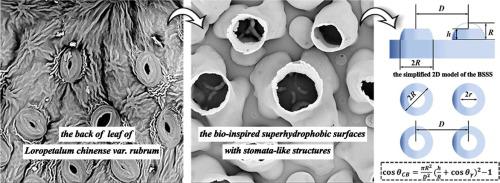Chemical Engineering Journal ( IF 13.3 ) Pub Date : 2020-06-18 , DOI: 10.1016/j.cej.2020.125935 Chang Lin , Yufang Huang , Xiao Li , Xue Sun , Weiying Zhang , Jianying Huang , Xiaoguang Ying , Minghua Liu

|
Fabrication of superhydrophobic surfaces by simple techniques is of significant interest. Herein, inspired by the “stomata effect” of plant leaves, a superhydrophobic surface with bionic stomata randomly on polydimethylsiloxane (PDMS) is fabricated by a facile swelling-vesiculating-cracking method. Neither multistep modification of nanostructure nor introduction of low surface energy substance is carried out during the fabrication. The water contact angle (CA) of the bio-inspired superhydrophobic surfaces with stomata-like structures (BSSS) can reach 168.4 ± 1° with 8.9° sliding angle and less than 10° contact angle hysteresis (CAH). The structure and wettability of the BSSS are characterized by scanning electron microscopy, Fourier transform infrared spectroscopy, energy dispersive spectrometry and X-ray photoelectron spectroscopy. The effects of swelling ratio, heat treatment temperature and surface morphology on the hydrophobicity of the BSSS are investigated systematically. Noticeably, the BSSS are provided with wonderful durability in organic solvents, ice water, and strong acid solution. Furthermore, a theoretical model for BSSS based on the Cassie-Baxter relation is established to elucidate the “stomata effect”. The model reveals that the water contact angle will reach 180° when the stomata-like structure is suitable. The fabrication of BSSS provides a potential strategy for the development of novel superhydrophobic materials.
中文翻译:

通过溶胀-微囊破裂法制备受植物叶片“气孔效应”启发的超疏水表面
通过简单的技术制造超疏水表面是令人关注的。在此,受植物叶片的“气孔效应”的启发,通过简便的溶胀-开孔-开裂方法制造了在聚二甲基硅氧烷(PDMS)上随机具有仿生气孔的超疏水表面。在制造过程中既不进行纳米结构的多步修饰也不引入低表面能物质。具有气孔状结构(BSSS)的生物启发性超疏水表面的水接触角(CA)可以达到168.4±1°,滑动角为8.9°,接触角滞后小于10°。BSSS的结构和润湿性通过扫描电子显微镜,傅立叶变换红外光谱,能量色散光谱和X射线光电子能谱表征。系统研究了溶胀率,热处理温度和表面形貌对BSSS疏水性的影响。值得注意的是,BSSS在有机溶剂,冰水和强酸溶液中具有出色的耐久性。此外,建立了基于Cassie-Baxter关系的BSSS理论模型,以阐明“气孔效应”。该模型表明,当气孔状结构合适时,水接触角将达到180°。BSSS的制造为新型超疏水材料的开发提供了潜在的策略。和强酸溶液。此外,建立了基于Cassie-Baxter关系的BSSS理论模型,以阐明“气孔效应”。该模型表明,当气孔状结构合适时,水接触角将达到180°。BSSS的制造为新型超疏水材料的开发提供了潜在的策略。和强酸溶液。此外,建立了基于Cassie-Baxter关系的BSSS理论模型,以阐明“气孔效应”。该模型表明,当气孔状结构合适时,水接触角将达到180°。BSSS的制造为新型超疏水材料的开发提供了潜在的策略。











































 京公网安备 11010802027423号
京公网安备 11010802027423号